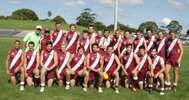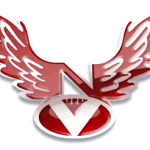Here's what I came up with. 24 teams, 2 leagues, 12 teams in each league who play each other twice. The winner of each leagues finals series would play off in the GF.
North-West League: WA, SA, NT, QLD
West Perth Falcons (WA)
East Perth Royals (WA)
Fremantle Dockers (WA)
South West Sharks (WA)
Port Adelaide Pirates (SA)
Norwood Redlegs (SA)
Central District Bulldogs (SA)
Northern Territory Thunder (NT)
Brisbane Broncos (QLD)
Redcliffe Dolphins (QLD)
Gold Coast Lions (QLD)
North Queensland Cowboys (QLD)
South-East League: NSW, ACT, VIC, TAS, NZ
North Sydney Kangaroos (NSW)
South Sydney Swans (NSW)
Western Sydney Giants (NSW)
Newcastle Knights (NSW)
Illawarra Hawks (NSW)
Canberra Owls (ACT)
Carlton Blues (VIC)
Collingwood Magpies (VIC)
Melbourne Demons (VIC)
Geelong Cats (VIC)
Tasmania Tigers (TAS)
New Zealand Warriors (NZ)
I know in reality it probably would've been something like 8 NSW teams, 5 Victorian teams, 4 Queensland teams, 2 WA teams, 2 SA teams, 1 Tasmania team, 1 ACT team, 1 NZ team, 0 NT team.
North-West League: WA, SA, NT, QLD
West Perth Falcons (WA)
East Perth Royals (WA)
Fremantle Dockers (WA)
South West Sharks (WA)
Port Adelaide Pirates (SA)
Norwood Redlegs (SA)
Central District Bulldogs (SA)
Northern Territory Thunder (NT)
Brisbane Broncos (QLD)
Redcliffe Dolphins (QLD)
Gold Coast Lions (QLD)
North Queensland Cowboys (QLD)
South-East League: NSW, ACT, VIC, TAS, NZ
North Sydney Kangaroos (NSW)
South Sydney Swans (NSW)
Western Sydney Giants (NSW)
Newcastle Knights (NSW)
Illawarra Hawks (NSW)
Canberra Owls (ACT)
Carlton Blues (VIC)
Collingwood Magpies (VIC)
Melbourne Demons (VIC)
Geelong Cats (VIC)
Tasmania Tigers (TAS)
New Zealand Warriors (NZ)
I know in reality it probably would've been something like 8 NSW teams, 5 Victorian teams, 4 Queensland teams, 2 WA teams, 2 SA teams, 1 Tasmania team, 1 ACT team, 1 NZ team, 0 NT team.




 covers more of the north, decent kit supplied
covers more of the north, decent kit supplied

